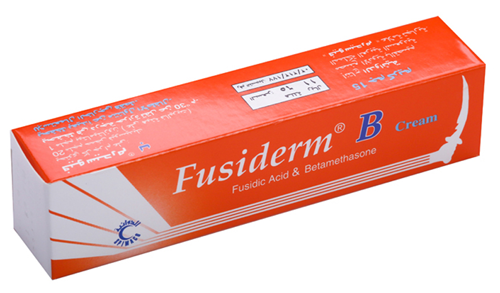Different types of dermatitis and a number of other skin health conditions may be cured with Fusiderm B. The remedy comprises two active components, Betamethasone topical 1.2mg, and Fusidic Acid topical 20mg.
The cream may be applied in the therapy of:
- Eczematous dermatoses including atopic eczema, congestive eczema, seborrheic eczema, and others.
- Skin infections;
- Impetigo;
- Psoriasis (except for psoriasis vulgaris);
- Atopic dermatitis;
- Abscesses;
- Skin allergy;
- Certain manifestations of corticoid-responsive dermatoses.
Your doctor can also prescribe Fusiderm B for some other skin problems.
Fusidic acid works as a natural antibiotic. Hence, it helps to slow down or stop the development of the infection and doesn’t let it spread further.
Fusiderm B is manufactured in a single strength – 1.2mg/20mg. The thin layer of cream should be applied to the affected areas of the skin two times daily. You may use the medication either under a bandage or without it. Using the bandage, the frequency of applying the remedy may be reduced to once daily.
Usually, a week or two is needed to get rid of the symptoms. Yet, only a specialist can determine how long the therapy should last based on the severity of the illness and your response to the treatment. In any case, you shouldn’t use Fusiderm B longer than for two weeks.
The dosing regimen and the frequency of applying the cream in children are the same as in adults. However, the treatment should be short-termed and not exceed 7 days.
Fusiderm B can’t be used in people with an allergy to one of the ingredients of the medication. Besides, it may provoke a reaction of hypersensitivity in people allergic to other corticosteroids. That’s why a consultation with a doctor before using the cream is obligatory.
Application of the drug under occlusive bandages for too long or on large areas of the skin may result in thinning of the skin and appearance of the stretch marks. That’s why it is better to use soft bandages or shorten the duration of treatment.
The preparation shouldn’t be used if you have:
- Cracks on the skin;
- Skin ulcers;
- Sunburns on the area of cream application;
- Open wounds;
- Viral skin infection;
- Bacterial dermatoses;
- Skin syphilis;
- Skin atrophy.
The cream should never be applied on the mucous membranes of the nose, mouth, penis or vagina. Use it with caution in case the affected area is close to the eyes. The medication shouldn’t be applied on eyes as it may provoke conjunctival irritation or glaucoma.
Fusiderm B is not effective against fungal infections. If your disease is exacerbated by fungus, stop using the cream until the infection is treated with an appropriate remedy.
Don’t apply too much cream to avoid peeling of the skin and other unwanted reactions.
Usage in the period of pregnancy is possible only during the second and the third trimester. It is not known how the drug may affect the unborn baby. That’s why you and your healthcare provider should outweigh all the possible risks for the fetus and benefits for the mother before starting the treatment.
Application of the cream in nursing patients is not advised. Stop breastfeeding the baby before using the preparation. In children, the preparation should be applied with caution and under close medical supervision.
When applied for a long period of time or when the layer of the cream applied is thick, Fusiderm B may provoke the following adverse reactions:
- Peeling and cracking of the skin;
- Itching, burning;
- Skin dryness;
- Irritation of the skin;
- Rash, acne;
- Erythema;
- Stretch marks appearance;
- Excessive hair growth (hypertrichosis);
- Pain and skin reaction in the area where the cream is used.
Inform your doctor about the reactions you experience to discuss the further tactic of treatment. If the symptoms don’t go away or even get worse, stop using the cream and turn for medical help.
Durable period of using Fusiderm B on large areas of skin may result in systemic side effects. Such reactions are possible both in adults and children:
- Low blood pressure;
- Cushing’s syndrome;
- Low immunity;
- Excessive blood glucose levels;
- Lowering of the pituitary gland function;
- Inhibition of growth and development in children;
- Worsening of adrenal glands functioning.
Any of these effects demand immediate discontinuation of treatment with Fusiderm B.



 (3 votes, average: 3.33 out of 5)
(3 votes, average: 3.33 out of 5)






























































